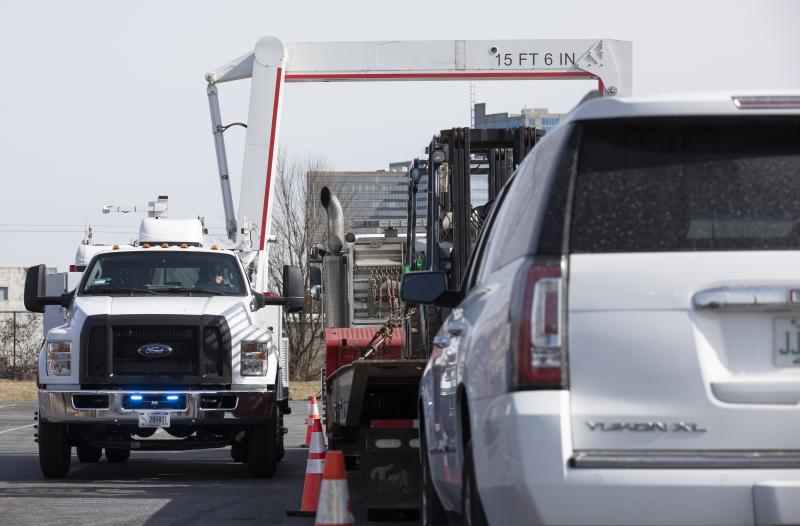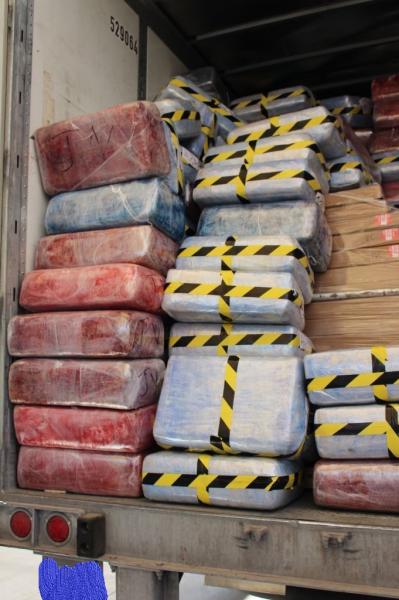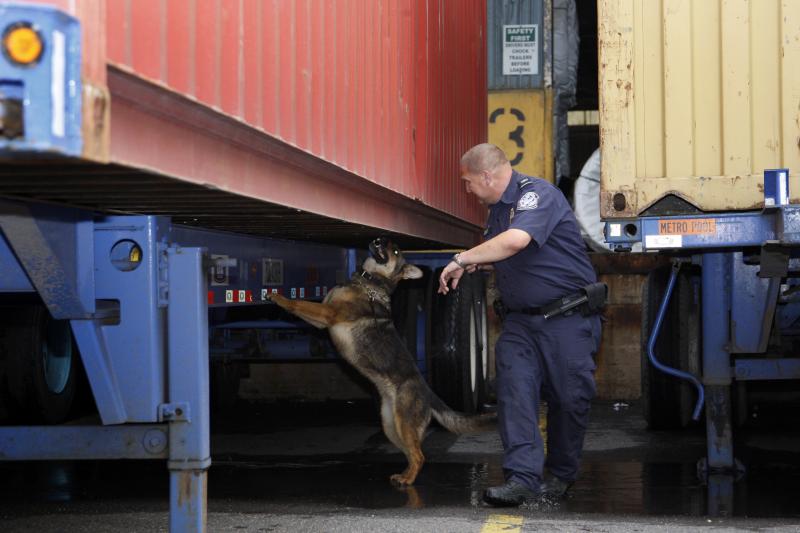
Breaking Bad Guys

U.S. Customs and Border Protection officer helps conduct a non-intrusive – better known as X-ray –inspection of a vehicle in Miami. Photo by Ozzy Trevino
Supervisory CBP Officer Matt Rode opened the back of a cargo truck near San Diego on May 28, and saw something that’s all too common at U.S. Customs and Border Protection’s more than 300 ports of entry: a large stash of drugs. In fact, this shipment had more than four tons of marijuana, not even that well-hidden.
“It was listed on the manifest as hot tubs, spas, and miscellaneous plumbing supplies. But [the marijuana] was just thrown in there from front to back,” getting the driver in hot water of his own, said Rode, who works as a member of CBP’s Anti-Terrorism Contraband Enforcement Team, a specialized unit set up to seize drugs, weapons, currency, and illicit contraband and part of CBP’s layered approach to drug enforcement. “They just throw it in there with the merchandise and hope they get lucky.”
It wasn’t an unexpected sight for Rode, as powerful X-ray machines and drug-sniffing dog teams had already alerted on the shipment, letting CBP officers know where to look. The size of the drug shipment wasn’t even that unusual, as the same port of entry saw just a few days later busts of more than 11,000 and 20,000 pounds of marijuana each. The entry point from Mexico in the Otay Mesa neighborhood of San Diego is the busiest in all of CBP in terms of the tonnage of drugs the officers encounter. For the entire San Diego Field Office, from Oct. 1, 2019 to May 30, 2020, officers seized:
- Nearly 81,000 pounds of marijuana– about half of the marijuana CBP seized during that time;
- 4,773 pounds of cocaine – 18% of the nationwide seizures;
- 1,141 pounds of heroin – more than a third of the national seizures by CBP;
- 54,572 pounds of meth – 56% of the nation’s seizures; and
- 911 pounds of fentanyl – nearly two-thirds of CBP’s seizures nationwide.
This time of year is particularly busy as it’s harvest time for marijuana south of the border. CBP has a harvest of its own, intercepting the illegal drugs that try to pour across the border. In fact, within a couple of weeks just after the May 28 bust, San Diego saw two more large marijuana seizures totaling more than 20,000 pounds.

“In the cargo area, it’s different than on the passenger side, as they try to take advantage of big conveyances,” said Supervisory CBP Officer Luis Silva, enforcement chief at the Otay Mesa Port of Entry. “Between March and May, we get the larger loads of marijuana, and it will pick up again in August, September and October.”
Silva said in between the large marijuana harvest times, they see upticks in other drugs such as methamphetamines, cocaine, heroin and fentanyl.

stopped approximately 8,200 pounds of
marijuana – worth approximately $2.5 million –
in a shipment of electronics May 28. Within a
couple of weeks, they would catch another 20,000
pounds of pot as drug smugglers tried to move their
seasonal bounty of the drug into the U.S. CBP photo
On a larger scale CBP-wide, the size of the recent drug shipments and how brazen they were could be indicators of how desperate drug smugglers are getting, especially as restrictions on non-essential travel due to the coronavirus pandemic at the ports of entry limit what passes through these portals into the United States. Stephen “Mac” McConachie, CBP’s liaison at the White House Office of National Drug Control Policy, compared it to the run on some grocery store items, such as toilet paper, that saw an inflated demand at the start of quarantines and has now returned to more level numbers as far as supply goes.
“People hoard things when they believe those products will become unavailable,” McConachie said. “Dealers, users, cartels – they all hoarded what they had. Now, they’re releasing their drugs, and the sudden spike in supply has pushed the price down. That leads to drug smugglers trying to move through larger and larger shipments to make up in volume what they lose in value.”
In fact, in the days leading up to COVID-19 restrictions in late March, CBP saw a surge in drug seizures of all types, as smugglers hurried to get their deadly products through the doors before they shut. In April, drug seizures went down significantly, but they were back to pre-COVID-19 levels in May and June. “The drug cartels are trying to respond to the changes at our borders,” McConachie said.
And it’s not just pot they’re trying to get past CBP officers. Montana Whitehead, an intelligence research specialist at CBP’s headquarters in Washington, D.C., said meth made a comeback in the last couple of years. In fact, during the COVID-19 pandemic, methamphetamine seizures never really fell off.
“Methamphetamine has seen our largest increases, up from about 20-30%,” during the past two fiscal years, Whitehead said. “It’s the only drug along the southwest land border where we did see consistent weights compared to previous quarters,” except during April’s initial downturn.
He went on to explain that meth is cheap to produce, production has gone through the roof, and the purity of the drug is at some of its highest levels ever.
“The markets have dramatically increased their demands for methamphetamine, and it all kind of coalesces into a perfect storm environment where they can move large weights without large cost investment risks,” that a drug such as cocaine might have, Whitehead said.
In fact, at the end of April when travel restrictions were at their highest, CBP officers in Laredo, Texas – another particularly busy port of entry for the agency – caught nearly 600 pounds of meth worth more than $11.5 million coming in in the back of a tractor-trailer. Just like the large marijuana shipments in California, powerful X-ray equipment and sharp-nosed dogs played significant roles in intercepting the illicit cargo hidden in a shipment of stone tiles. The increases weren’t seen just along the southern border. For example, from mid-March to mid-June, CBP officers in Buffalo, New York, saw drug seizures grow a whopping 4,000% compared to the same time a year earlier.

Whitehead added his office works closely with fellow state, local and federal law enforcement agencies, such as the Drug Enforcement Administration, to take a whole-of-government approach to stop drugs from entering the country.
CBP’s efforts have been helped by the sharp reduction in personal vehicles – which carried more and smaller loads – coming through the ports of entry and the rise in commercial trucks loaded down with larger quantities of drugs. More CBP officers were taken out of the personal owned vehicle traffic lanes, where they were trying to screen thousands of cars and trucks every day, and moved to the commercial truck operations, where the numbers might be in the dozens. Fewer targets meant more hits, and those hits were larger because they were in tractor-trailers, and not hidden in a trunk or body panels of a car.
“With that change of workload, we were able to keep our enforcement focused and continue to have individuals work the commercial environment,” who would normally work personal vehicles, said Greta Campos, director of Tactical Operations for the Office of Field Operations, the component of CBP responsible for running the land, air and sea ports coming into the country. But she is quick to point out drugs coming in personal cars, trucks and SUVs have seen an uptick again. “We’re still getting a significant number of seizures out of [personally owned vehicles].”
Without tipping their hand at how CBP knows smugglers are changing their tactics, Campos did say the agency has adjusted to the changes the crime bosses tried to make.
“The criminal organizations will smuggle whatever folks want, and they will try to have diversified ‘business interests,’” she said. “When they attempt to do that through or between our ports of entry, we in CBP work very hard to detect, intercept, identify and prosecute those individuals who are doing so. We strive to stay one step ahead of our adversaries.”
She cited the close cooperation from her office with the people in CBP’s intelligence channels, such as Whitehead, to see any changes in tactics or products.
“When we see, for instance, that the [Drug Enforcement Administration] is reporting that the price of meth has gone up in certain areas, we can recognize there’s a higher demand and lower supply that indicates a level of desperation [on the criminals’ parts],” Campos said.
Whitehead said the drop off and the resurgence of a lot of drug smuggling during COVID-19 shows interdiction efforts are important and never really subside, pandemic or not.
“The COVID-19 crisis is obviously temporary,” he said. “Methamphetamine was impacted in a minor way, at best, showing a very strong supply chain from production to smuggling to demand within the United States.”
Whether the latest surge is marijuana, meth or opioids, and is driven by travel restrictions, harvest time considerations, or by demands from the users in the U.S., Rode said they’re ready for whatever the smugglers attempt.
“They’re just hoping to try and get by,” he said. “We’re prepared for whatever they try to do.”
CBP officers at the Port of Savannah, Georgia, made a port-record 2,133-pound seizure of cocaine on Oct. 29, 2019. The cocaine was found in a container of scrap aluminum and copper being shipped from South America to Europe. CBP photo by Ozzy Trevino


